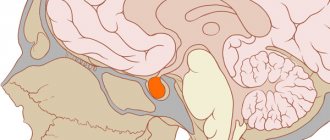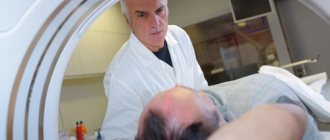A common disorder is cerebral vascular sclerosis, which can manifest itself not only in older people, but also in much younger patients. The pathology is characterized by the destruction of vascular walls, which become less elastic, their lumen narrows and plaques form. For a long time, cerebral vascular disease is not accompanied by any pathological symptoms, but as the disease progresses, the patient experiences headaches, tinnitus and other unpleasant symptoms that require urgent medical attention.
In advanced cases, sclerotic plaques in the vessels of the brain can provoke an epileptic attack, ischemic stroke and other complications that threaten the patient’s life.
What is it and what is the mechanism of development of cerebral damage?
In the case of cerebral sclerosis, it all begins with the formation of small cholesterol plaques in its vessels, which, as they accumulate, can turn into blood clots, almost completely disrupting blood circulation in the brain.
Since the human brain is actually a “control point” for the body, this state of affairs can be very dangerous. Blockage of blood vessels in the brain inhibits the flow of oxygen and nutrients into the organ, thereby disrupting the functioning of its cells. Over time, this leads to the formation of scars and cysts. Sometimes plaques completely block some vessels, causing their death and, as a result, a stroke.
The development of cerebral vascular sclerosis occurs in a special way. Conventionally, this process can be divided into several stages:
Stage 1 – formation of fatty streaks . Cholesterol gradually accumulates on the inside of the blood vessels in the form of spots and stripes.- Stage 2 – liposclerosis . Lipid stains deposited on the walls of blood vessels begin to connect with each other, becoming overgrown with connective tissue: as a result, a cholesterol plaque is formed. Its surface cracks, becomes covered with ulcers, small parts can come off from it and, spreading through other vessels, clog them.
- Stage 3 – atherocalcinosis . The plaque becomes denser due to the deposition of calcium salts on its surface. This can lead to complete blockage of blood vessels.
Causes
The process begins with the formation of lipid plaques on the walls of blood vessels. They disrupt the functioning of the system. Initially, the vessels dilate due to deposits, but then their elasticity decreases and stenosis—narrowing—appears. More often the disease is diagnosed in men, mainly the elderly.
Risk factors and provoking diseases:
- Hereditary predisposition.
- Arterial hypertension is a persistent increase in systolic and diastolic pressure.
- Endocrine diseases (diabetes mellitus).
- Obesity of any stage.
- Nicotine, alcohol addiction.
- Poor nutrition – fasting or consuming large amounts of fatty foods.
- Stress, neurosis, emotional shock.
- Physical inactivity (low physical activity).
- Pathologies of the cardiovascular system.
- Viral diseases - herpes.
- Chronic infectious processes.
- Inflammation of any localization.
Attention! At risk are men over 45 years of age and women over 60 years of age.
Causes of the disease and risk factors
Reference! The disease in question is most susceptible to males over the age of 50.
But, unfortunately, there are some exceptions when cerebral vascular sclerosis also appears in representatives of the younger generation, which can be triggered by certain factors present in their lives:
- Physical inactivity (sedentary lifestyle).
- Insufficient physical activity.
- Incorrect diet (lack of it as such).
- Poor nutrition.
- Obesity.
- Bad habits (smoking, alcohol).
But there are also factors that, unfortunately, simply cannot be avoided. These are the main causes of the disease :
- Diabetes.
- Genetic predisposition.
- Metabolic disorders.
- Hormonal imbalances.
- Hypertension.
- Endocrine diseases.
- Frequent and severe stress, leading to physical and emotional exhaustion, etc.
The etiology of the disease is still being studied. To date, scientists have concluded that there are two main causes of cerebral atherosclerosis:
- natural aging of the body;
- vascular damage.
There are also factors that can influence the development of the disease:
- formation of cholesterol plaques on vascular walls;
- they arise against the background of a violation of lipid (fat) metabolism in the body;
- People who are overweight are primarily at risk.
The secondary reasons that provoke cerebral vascular sclerosis include:
sedentary lifestyle;- hereditary factor;
- metabolic disease;
- endocrine disorders;
- the presence of bad habits such as smoking, alcoholism, drug addiction;
- high blood pressure;
- vascular disorders;
- errors in nutrition, a lot of fatty and fried foods in the diet;
- diabetes;
- overweight;
- hormonal disorders;
- stressful situations;
- age.
Main groups of drugs for treating the disease
Depending on the degree of vascular damage, third-party diseases, the patient’s condition and individual contraindications, the attending physician prescribes drugs from several groups:
- statins;
- fibrates;
- a nicotinic acid;
- ion exchange sequestrants;
- hypolipid drugs;
- anticoagulants;
- antiplatelet agents;
- antioxidants.
At the early stage of plaque formation, either statins or fibrates are sufficient for effective treatment. However, as the disease develops, it is impossible to cure atherosclerosis with only one group of drugs, so doctors combine drugs to obtain a favorable result.
Statins
This is the main group of drugs used for cerebral atherosclerosis and for preventive purposes. Statins or reductase inhibitors have lipid and non-lipid properties. The lipid-lowering effect is caused by the ability of the drug to lower total cholesterol by reducing LDL. The maximum level of LDL reduction depends on the dosage, and can reach 60%.
To reduce triglycerides, statins are prescribed if their content in the blood is no more than 4.4 mmol/l. During treatment, their level can be reduced by a third. If the content of triglycerides is high (over 10 mmol/l), the drug is prescribed in combination with fibrates and nicotinic acid. Complex therapy can increase HDL levels by 5-15% and halve the number of triglycerides.
Non-lipid manifestations of statins are:
- decreased activity of inflammatory mediators;
- reduction of oxidative processes of LDL and phospholipids;
- activation of the function of a single layer of cells;
- increased T-lymphocyte volume;
- improvement of bone condition;
- decreased lithogenicity of bile.
Statin drugs for the treatment of cerebral atherosclerosis have a positive effect on blood pressure and anticancer activity. However, it is not advisable to take them if liver disease is diagnosed, since the risk of developing liver failure increases.
Fibrates
The group of fibrates includes fibric acid derivatives. They are prescribed to reduce the liver's production of low and very low density lipoproteins, to prevent their spread and the emergence of new lesions. Tablets of the fibrate group have additional effects such as:
- stabilization of metabolism;
- removal of inflammatory processes;
- relieving emotional stress.
The simultaneous administration of fibrates, nicotinic acid and statins helps stop the development of pathology and reduces the mortality rate from heart attacks and strokes. The course of medication depends on the patient’s condition, and 2-3 tablets are usually prescribed per day.
Negative effects from taking include: nausea, vomiting, headache, diarrhea, migraine. Frequent and prolonged use can cause depression and leukopenia in the blood. Abuse also negatively affects the functioning of the heart and brain.
A nicotinic acid
The effect of nicotinic acid in cerebral atherosclerosis is as follows:
- lowering cholesterol, triglycerides and LDL levels;
- replenishment of niacin deficiency;
- stimulation of the cardiovascular system;
- decreased activity of fat breakdown;
- relieving dizziness;
- normalization of the central nervous system;
- vasodilation.
Medicines based on nicotinic acid form a group of vitamins B3, soluble in water. Regular use allows you to:
- prevent heart attacks;
- get rid of depression;
- improve the functioning of the gastrointestinal tract;
- restore sleep.
It is also prescribed for mild diabetes mellitus, stomach ulcers, poorly healing wounds, infectious diseases and inflammation of the small or large intestine. Side effects of the drug include redness of the skin, flushing of the face, and hypotension. Large doses can lead to fatty liver, diarrhea, vomiting, arrhythmia, and irritation of the gastrointestinal mucosa.
Ion exchange sequestrants
The main purpose of sequestrants is to bind bile acids in the intestines, preventing their reuse in the liver and accelerating the removal of acids from the body. After taking the drug, the consumption of total cholesterol increases, which leads to a decrease in LDL by 15-30%.
Cholestyramine and colestipol come in powder form, but it is insoluble in water and has an unpleasant taste. They are usually mixed with juice or washed down with plenty of water. Side effects occur only when the medication is not taken regularly and are expressed in digestive disorders. Overdose and taking the drug in large doses for a long time causes a violation of the absorption of fat-soluble vitamins and folic acid.
Sequestrants are recommended for patients with slightly elevated LDL levels or to prevent the development of atherosclerotic plaques. For persistently high cholesterol, they are prescribed in addition to statins.
Hypolipid drugs
Hypolipid group drugs include drugs that lower cholesterol levels without affecting triglycerides. They are prescribed in addition to statins, fibrates and a low-cholesterol diet.
Proburcol is prescribed to lower cholesterol by increasing the protein in the blood that delivers cholesterol to the liver with its subsequent removal from the body. Unsaturated fatty acids help reduce saturated fatty acids. The effectiveness of ezetrol is based on the uniform distribution of the main active ingredient on the intestinal villi, which leads to a decrease in the volume of fatty acids entering the stomach with food.
Pantheine activates oxidative and enzymatic processes, accelerates fatty acid metabolism and increases HDL levels. Lipomal prevents the absorption of fatty acids and the growth of cholesterol production in the liver.
Antiplatelet agents
This group of drugs is used to treat cerebral atherosclerosis and as a prophylactic against the formation of blood clots. Antiplatelet agents prevent platelets and red blood cells from combining and help increase blood fluidity. Antigout, vasodilator and antispasmodic medications are used as antiplatelet agents.
The mechanism of action of the drug is due to the ability to disrupt the metabolism of arachidonic acid, increase the intracellular level of cyclic amphetamine and affect the state of the cytoplasmic membrane of platelets.
Aspirin reduces platelet activity for a full life cycle of 7 to 10 days. This unique property is used to prevent thrombosis, stroke, and heart attack. Despite the benefits, prolonged or incorrect use of aspirin can cause complications:
- allergies up to Quincke's edema;
- anemia of posthemorrhagic, iron deficiency or hemolytic form;
- gastrointestinal pathology;
- bleeding gums;
- dizziness;
- hemorrhagic stroke;
- attacks of suffocation;
- acute renal or liver failure.
Glycine is classified as a vasodilator drug prescribed for atherosclerosis. Additionally, the drug strengthens the nervous system and improves brain function.
Anticoagulants
Blood clotting is important for protecting the body when the walls of blood vessels are damaged. When blood clots, it forms a clot that stops bleeding. Under certain circumstances, blood clots can also form inside a vessel. This pathological condition can lead to disruption of the functioning of an organ or system, and even to death.
Anticoagulants are medications for cerebral atherosclerosis that reduce the activity of the coagulation process and prevent thrombus formation. Their role in the treatment of pathology is great: direct-acting drugs reduce the activity of thrombin in the blood, and indirect-acting drugs reduce the formation of prothrombin.
Anticoagulant drugs have few side effects, and usually an overdose leads to severe headache, vomiting and nausea, and impaired kidney function.
Antioxidants
Antioxidant drugs correct the energy metabolism of the brain. The effectiveness of therapy for acute and chronic cerebrovascular processes has been proven by medical observations. All biological and artificial antioxidants are divided into 2 types: fat-soluble and water-soluble.
Among the fat-soluble ones, a-tocopherol is most often prescribed, which interacts with the hydroxyl radical OH and suppresses singlet oxygen. Water-soluble antioxidants include glutathione, which is necessary to protect cells from toxic oxygen intermediates. This group also includes ascorbic acid. It is involved in the stabilization of oxidative and reduction processes, in the process of blood clotting and carbohydrate metabolism.
Symptoms
Symptoms of cerebral sclerosis directly depend on which particular area of the brain does not receive the required amount of oxygen. The fact is, each area of the brain controls certain functions of the human body, and the symptoms of the disease will manifest themselves accordingly.
One of the first signs of illness is a headache - this is a signal from the body that a malfunction is occurring. However, such a seemingly insignificant symptom is often ignored by a person or attributed to weather dependence.
Many people live with headaches for years and get so used to them that they don’t even react to them. However, headache is a formidable symptom that requires mandatory consultation with a doctor and a thorough examination.
In addition to headaches, patients may complain of the following symptoms:
- presence of noise and ringing in the head;
- flashes of light before the eyes, spots, lightning;
- dizziness;
- impaired coordination of movements;
- memory impairment;
- sleep problems;
- deterioration of fine motor skills;
- nervous breakdowns, tearfulness, suspiciousness.
Are common
Attention! The signs of the disease manifest themselves clearly, and therefore it becomes clear to the specialist at the very first examination of the patient what kind of disease the person has. This allows the patient to be referred to a specialist as soon as possible, undergo the necessary diagnostics and begin treatment.
Main signs of the disease:
- constant headaches;
- presence of dizziness;
- nausea and vomiting;
- increased body temperature;
- general weakness;
- increased sweating;
- fast fatiguability;
- general weakness;
- insomnia.
Constant oxygen starvation leads to the gradual death of brain cells, therefore, the disease goes through three main stages.
At the first stage
Throbbing or pressing pain appears in the head, creating a feeling of fullness. With physical or mental stress, the pain intensifies. The same thing happens during times of stress or when being in a stuffy room. The pain may appear only in the morning or evening or may not depend on the time of day.
As a result, a person becomes irritable, sleep suffers at night, and concentration decreases. Performance decreases. A man complains of tinnitus. It develops before headaches. At times I suffer from dizziness and unsteadiness of gait.
On the second
At this time, a person’s psychological background changes. Lethargy is observed, emotional activity disappears, and mental activity decreases.
It is difficult for a person to remember recent events, but the events of past years are remembered very well. Due to a decrease in concentration, a person’s ability to work decreases, and professional skills are lost. It is difficult to remember what you read and hear, and speech suffers.
On third
At a deep stage of the disease, it is the memory that suffers. A person cannot remember events that happened to him quite recently.
Because of this, he is unable to perform his daily duties and becomes professionally unfit. It is very difficult for such a person to communicate in a team and have a normal psychological background. Gradually, this condition leads to serious complications such as heart attack, stroke or dementia.
Types of cerebral vascular sclerosis
Sclerosis of the cerebral vessels has one unpleasant feature: in the early stages it is almost impossible to diagnose the disease , so its symptoms can be identified only when it has already begun to actively develop.
Atherosclerosis of cerebral vessels can be divided into 2 types, each of which has its own symptoms: stenotic and non-stenotic. The first type of disease develops at a rather slow pace, and accordingly, symptoms appear gradually. So, the first alarm bells should be considered:
- Unstable emotional background.
- Sleep disorders (insomnia/drowsiness).
- Absent-mindedness.
- Headaches along with dizziness.
- Decreased level of performance.
The manifestation of the disease is much more serious at the late stage of development of stenotic sclerosis of the cerebral vessels:
- Weak manifestation of the pupils to a light stimulus.
- Severe impairment of memory and attention functions. At this stage of the disease development, micro-strokes, frequent dizziness and fainting are possible. Often, all of the listed unpleasant symptoms lead to paralysis (both partial and complete).
- Extensive cerebral vascular ischemia manifests itself in the form of irreversible impairment of cognitive processes.
Non-stenotic atherosclerosis affects the human brain through the brachiocephalic artery , which continuously supplies it with blood directly from the heart.
Attention! Disturbance in the functioning of the vessels of this artery leads to overload of the brain vessels, which ultimately leads to stroke or encephalopathy.
Unfortunately, in the early stages the disease does not manifest itself in any way. Thus, only some symptoms, if identified correctly, “signal” danger:
- Noise in ears.
- Dizziness.
- Weakness of the whole body (with numbness of the lower extremities in some cases).
- Darkening in the eyes.
Read more about the causes, symptoms and treatment of cerebral vascular sclerosis in our material.
Classification of forms of the disease
Atherosclerosis is a systemic disease that affects all arteries, however, depending on the predominance of the severity of atherosclerosis in a particular group of vessels, it is divided into:
- atherosclerosis of the coronary arteries (causing coronary heart disease and angina, which can result in myocardial infarction),
- atherosclerosis of the brachiocephalic arteries (causing chronic insufficiency of cerebral blood flow, which can result in a stroke),
- atherosclerosis of the aorta, iliac arteries and arteries of the lower extremities (causing intermittent claudication, which can result in gangrene of the lower extremity or fingers),
- atherosclerosis of the visceral branches of the aorta (impaired blood flow in the internal organs, which can result in infarction of the intestine, kidney, etc.),
- multifocal atherosclerosis (damage to several of the above groups of vessels).
Diagnostics
For timely and, most importantly, correct treatment of the disease, it should be diagnosed in time. For this purpose, you need to contact an experienced neurologist who will collect anamnesis, prescribe, if necessary, some tests (general urine/blood analysis, blood biochemistry) and conduct a comprehensive computer study of the brain:
- Ultrasound of the vessels of the head and neck . Using this procedure, the condition of the external vessels of the head and neck, as well as the vessels located under the skull, is determined. As one of the components of the procedure, a duplex scan of the brain is performed, which allows you to get a complete picture of the condition and functioning of the brain vessels, as well as assess the state of blood flow.
- Angiography of cerebral vessels . A contrast agent is injected into the vascular bed, which makes it possible to assess the state of the blood flow and the vessels themselves.
Surgical methods for treating atherosclerosis
- elimination of atherosclerotic plaque by open surgery on the vessel,
- expansion of the lumen of the vessel from the inside using special instruments and installation of a metal frame that prevents further narrowing,
- when the lumen of the vessel is completely closed by a plaque, a bypass operation is performed (a bypass of the blood flow).
Surgical treatment is prescribed when the risk of developing disabling complications without surgery exceeds the development of such complications after surgery.
Treatment
To prevent the process of vascular sclerosis or at least restrain its development, it is necessary to take a serious approach to treating the disease. It should consist of a whole range of procedures and actions aimed at destroying sclerotic plaques:
- Proper nutrition. The diet should be balanced: with a sufficient amount of vitamins and minerals, as well as a moderate amount of vegetable/animal fats. The following products should predominate in the diet:
- vegetables fruits;
- fish, seafood;
- dietary meat;
- It is advisable to minimize the consumption of foods high in cholesterol (eggs, fatty meats, baked goods and pasta).
- Physiotherapy. Physical activity should be included in the treatment program:
- they should be moderate;
- strictly corresponding to gender;
- be suitable for age;
- take into account the patient's condition.
- Taking medications . Treatment of the disease must be accompanied by the mandatory intake of certain medications for sclerosis. Their action is aimed at improving blood supply to the brain, normalizing sugar and blood pressure levels, normalizing the amount of lipids in the blood, etc. The prescription of medications should be made by a doctor after a thorough diagnosis.
- Manual therapy. It is designed to qualitatively relax muscle tissue in places where cholesterol plaques accumulate. This procedure should be performed by qualified medical personnel. High-quality work on the muscles located along the vessels will eliminate venous hypertension, increase the strength of muscle chains, blood circulation in the problem area, etc.
- Acupuncture . Oriental therapy also helps well in the fight against vascular sclerosis. The use of an acupuncture system will help reconfigure the body, especially the diseased organ, as well as the parts of the body that are associated with it. It also relaxes muscles, providing better blood circulation, thereby softening cholesterol plaques and washing them away.
- Folk recipes. Well-known recipes from traditional medicine (herbs) can contribute:
- onion-honey tincture (onion juice and honey are mixed in equal proportions and taken 3 times a day before meals);
- a mixture of thyme and mint (about 1 tbsp) is brewed with 2 tbsp. boiling water, infused for about half an hour, and taken 2-3 times a week.
Prevention
Treatment of cerebral vessels is not an easy process, requiring a comprehensive and correct approach.
Important! As you know, prevention of disease is better than any treatment.
To prevent the development of cerebral vascular sclerosis, it is enough to follow simple but effective rules:
- to live an active lifestyle;
- include physical and intellectual activity in your life (balanced);
- Healthy food;
- have a good rest;
- ensure normal sleep;
- give up bad habits, etc.
Atherosclerosis of cerebral vessels is a chronic disease . The disease is prone to relapses, so it is worthwhile to prevent exacerbations during periods of remission. They are based on:
use of medicinal herbs;- diet therapy;
- It is better to add vegetable oil to salads instead of sour cream;
- drink freshly squeezed potato juice daily;
- to strengthen the body as a whole, it is recommended to include fresh onions and horseradish leaves in the diet;
- dried fruits will be useful;
- moderate physical activity has a beneficial effect on the body;
- rejection of bad habits.
Keep your emotions and blood pressure under control. Then you will be able to prevent the development of complications that often appear with cerebral vascular sclerosis. Eat right, exercise actively, and eliminate bad habits from your life.
In general, cerebral vascular sclerosis is not so terrible if it is diagnosed/prevented in a timely manner, and for this you need to carefully monitor the condition of your own body and treat it with care . Be healthy!










